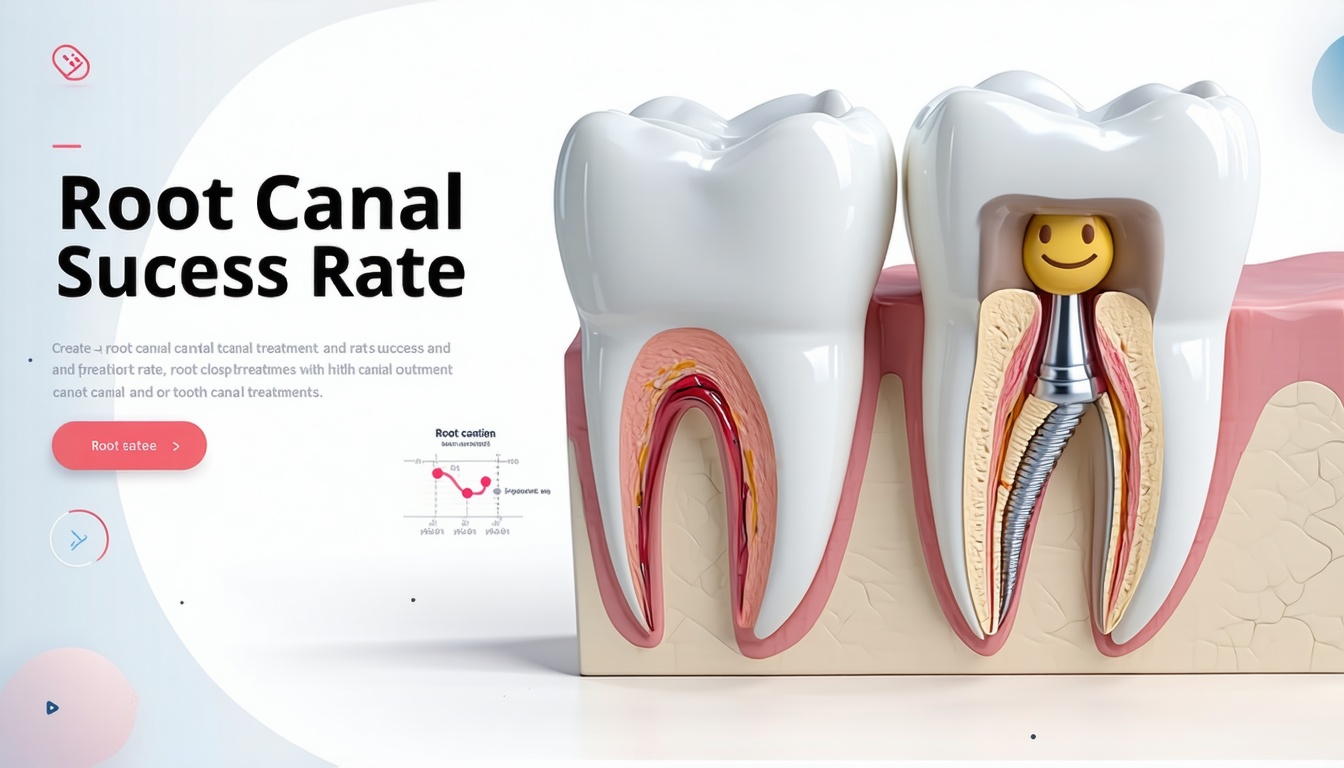Understanding Root Canal Success
Understanding the success of root canal treatments is crucial if you are considering this procedure to alleviate dental pain and preserve your natural teeth. The success rate of a root canal can vary based on several factors, including the duration of results and other influencing elements.
Duration of Root Canal Results
Most root canals are successful and can last for many years, often a lifetime (Cleveland Clinic). With proper aftercare, the treated tooth can continue functioning effectively, allowing you to maintain your smile and enjoy your favorite foods. The following table outlines the cumulative survival rates for teeth that have undergone root canal treatment over different timelines:
| Duration After Treatment | Cumulative Survival Rate (%) | Endodontic Success Rate (%) |
|---|---|---|
| 10 years | 97 | 93 |
| 20 years | 81 | 85 |
| 30 years | 76 | 81 |
| 37 years | 68 | 81 |
The longevity of root canal results indicates that when well-maintained, treated teeth can remain healthy for decades, contributing to your overall oral health.
Factors Influencing Success Rates
Several factors can influence the success rates of root canal treatments. These include:
-
Dentist Expertise: The skill level of the dental professional performing the procedure can significantly affect the outcome. An experienced endodontist may achieve higher success rates due to their proficiency in handling complex cases.
-
Condition of the Tooth: The state of the affected tooth prior to treatment plays a vital role. Teeth with more extensive decay or prior infections may face more challenges during treatment, affecting the success rate.
-
Complexity of Root Canal Systems: The anatomy of the root canal itself can vary widely. Teeth with complex root systems may be more difficult to treat, potentially decreasing the likelihood of a successful outcome.
Statistics from recent studies indicate high longevity and success rates of endodontically treated teeth, reporting success rates of 87.8% and 80.8% at the tooth and patient levels, respectively (PubMed Central). Understanding these factors can help you make informed decisions about your dental care.
If you would like to learn more about the root canal treatment process, check out our articles on what is a root canal and how long does a root canal take.
Technological Advancements in Root Canals
Modern technologies have significantly improved root canal procedures, enhancing success rates and patient comfort. These advancements include the use of ultrasonic instruments, nickel-titanium rotary files, and improved anesthetic options.
Impact of Ultrasonic Instruments
The introduction of ultrasonic instruments in root canal therapy has led to higher success rates. These tools ensure thorough disinfection during treatments, which is crucial in preventing infection and promoting healing. Ultrasonic devices help in the effective removal of debris and bacteria from the intricate root canal system, making them an invaluable addition to modern endodontic practices. For more information on root canal definitions, visit our article on what is a root canal.
Role of Nickel-Titanium Rotary Files
Another significant advancement is the use of nickel-titanium rotary files. These files are flexible and can navigate the curved anatomy of the canals more effectively than traditional stainless-steel files. This flexibility enhances the speed and efficiency of the procedure while maintaining the natural shape of the tooth’s anatomy. The use of these rotary files not only optimizes the cleaning process but also contributes to better overall outcomes in terms of the root canal success rate. For a step-by-step guide on this procedure, check our article on root canal procedure steps.
Advancements in Anesthetics
Advancements in local anesthetics have also transformed the root canal experience. Newer techniques and sedation options have made treatments significantly less painful. These innovations provide a more relaxed experience for patients, which can alleviate anxiety associated with dental procedures. Improved anesthetics ensure that discomfort is minimized, making the process more tolerable. If you’re seeking tips for relieving pain following treatment, you can find helpful insights in our article on root canal pain relief tips.
In summary, these technological advancements are crucial to improving both the effectiveness and comfort of root canal treatments. As these technologies continue to evolve, they will contribute further to the preservation of natural teeth and overall dental health.
Expertise and Tooth Condition
When considering the root canal success rate, two major factors come into play: the expertise of the endodontist and the condition of the tooth prior to treatment. Understanding these aspects can help you make informed decisions about your dental care.
Influence of Endodontist Expertise
The experience and skill level of the endodontist performing your root canal significantly impact the outcome of the procedure. Endodontists receive specialized training beyond dental school, focusing specifically on root canal therapy. This training equips them with the knowledge to navigate complex cases and utilize advanced technology, ultimately enhancing the success rates of treatments (Johnson Endodontics).
A more skilled endodontist can tackle challenging situations more effectively, potentially leading to a higher likelihood of success and less need for follow-up procedures. It’s important to choose a well-reviewed professional who has a good track record in performing root canals, particularly if your case is expected to be complicated.
Tooth Condition Prior to Treatment
The condition of your tooth before the root canal procedure also plays an essential role in determining its success rate. For instance, teeth that exhibit severe decay, fractures, or extensive damage may be more challenging to treat successfully. When these issues are present, the potential for complications increases, particularly if handled by an inexperienced endodontist (Johnson Endodontics).
Here is a quick reference table showing common tooth conditions and their potential impact on root canal success:
| Tooth Condition | Impact on Success Rate |
|---|---|
| Healthy Tooth | High success rate |
| Mild Decay | Moderate success rate |
| Severe Decay | Lower success rate |
| Fractured Tooth | Variable success rate |
| Extensive Damage | Low success rate |
Root Canal System Complexity
The complexity of the root canal system can also influence the success of the treatment. Each tooth has a unique root canal structure, and molars, for example, often feature multiple roots and intricate canals. These complexities can pose significant challenges during treatment (Johnson Endodontics).
Working with an expert endodontist ensures that all tissue is thoroughly removed during treatment, increasing the chances of a successful outcome. If the root canals are not adequately cleaned and sealed, the likelihood of re-infection rises. Patients with complex tooth anatomy should prioritize finding an endodontist experienced in handling such cases for optimal results.
For more detailed insights on the process and benefits, you may want to check out our explanations on what is a root canal and root canal vs tooth extraction.
Microscopes and Disinfection Techniques
In modern root canal treatment, the use of advanced tools such as microscopes and proper disinfection techniques plays a crucial role in determining the overall success rate of the procedure.
Integration of Microscopes
The integration of microscopes into root canal procedures has brought significant improvements in precision and efficiency. Using microscopes, such as ZEISS microscopes, enhances visibility for endodontists. This heightened visibility allows for more precise removal of infected tissue and contributes to success rates of up to 98% in some cases (Liv Endodontics). By enabling better access to the intricate canal systems within the teeth, microscopes can help ensure that all infected or damaged tissue is thoroughly addressed.
Proper Disinfection Methods
Proper disinfection methods are critical in achieving successful root canal treatment. The introduction of ultrasonic instruments has improved disinfection processes during therapy, ensuring that all bacteria are effectively managed. These instruments enhance the removal of debris and bacteria from the root canal, which, if left untreated, could lead to lower success rates and potential reinfection (Sola Dental Spa).
| Method | Effectiveness (%) |
|---|---|
| Microscopic visibility | Up to 98 |
| Ultrasonic disinfection | Increased efficiency |
Proper cleaning and sealing techniques, as well as the use of materials that are compatible with the root canal environment, are also essential. Ensuring that these steps are meticulously executed contributes significantly to the procedure’s overall effectiveness.
Influence of Bacteria and Health
The type of bacteria present in the tooth can greatly influence the success of a root canal. Some bacteria may be resistant to standard treatment methods, leading to increased risks of reinfection. Therefore, meticulous disinfection techniques are paramount in lowering the risk of complications (Johnson Endodontics).
Long-term oral health also influences how well a patient responds to root canal treatment. Individuals with health issues or weakened immune systems may experience varying success rates. By understanding these factors, you can better prepare for your procedure and discuss specific concerns with your endodontist.
Considering these elements, the integration of state-of-the-art microscopes and robust disinfection strategies in root canal therapy maximizes your chances of a successful outcome. For a deeper understanding of the purpose and steps involved in root canal treatment, visit what is root canal treatment.
Non-Surgical Root Canal Success
When considering a non-surgical root canal treatment, there are several critical factors to keep in mind that influence the success rate of the procedure. Your dentist’s skill level, various factors affecting the treatment, and the importance of proper cleaning and sealing all play vital roles.
Dentist Skill Level
The experience and proficiency of the dentist performing the non-surgical root canal treatment significantly impact its success. Skilled practitioners are more adept at navigating the complexities of root canal systems and can better identify any underlying issues that may affect the treatment process. According to Paradise Valley Dental, a highly qualified dentist can increase your chances of a favorable outcome.
Factors Affecting Non-Surgical Root Canals
Several factors influence the success rates of non-surgical root canals. These include:
- Tooth Condition: The health of the tooth before treatment is crucial. Predisposing conditions can lead to complications in the recovery process (Johnson Endodontics).
- Bacterial Presence: The type of bacteria in the tooth can significantly affect treatment outcomes. Some strains may be more resistant to treatment (Johnson Endodontics).
- Infection Severity: A more severe infection can complicate the procedure and reduce success rates. Other factors such as root canal shape and overall health also contribute to the process (Paradise Valley Dental).
| Factor | Impact on Success Rate |
|---|---|
| Dentist Expertise | High |
| Tooth Condition | Moderate |
| Bacterial Presence | High |
| Infection Severity | High |
Cleaning and Sealing Importance
The cleaning and sealing process is one of the most critical steps in a non-surgical root canal treatment. Proper cleaning ensures that all infected tissue and bacteria are removed from the root canal system. According to Paradise Valley Dental, correct obturation, or sealing of the root canal, is also essential to prevent future infections. Inadequate cleaning or sealing increases the risk of complications and may necessitate further procedures.
Understanding these key aspects can help you make an informed decision about root canal treatment. If you are experiencing persistent discomfort, consider consulting with a qualified dentist to discuss your options. For more information about the procedure, you can read about what is root canal treatment and the root canal procedure steps.
Modern Technology in Root Canal Procedures
In today’s dental landscape, advancements in technology have significantly improved root canal treatments. This includes tools and techniques designed to enhance precision, comfort, and effectiveness. Here, you will learn about three key technological innovations: CBCT imaging, EdgePRO laser technology, and ZEISS microscopes.
CBCT Imaging Benefits
Cone Beam Computed Tomography (CBCT) is a revolutionary imaging technology allowing for detailed 3D imaging of the tooth structure. This technology aids endodontists in creating accurate diagnoses and customized treatment plans, ultimately leading to higher root canal success rates. The benefits of CBCT imaging include:
| Benefit | Explanation |
|---|---|
| Detailed Visualization | Offers a 3D view of the root canal system, including anatomy and potential complications. |
| Accurate Diagnoses | Enables precise identification of infections and anomalies. |
| Customized Treatment Plans | Allows for tailored treatments based on individual conditions. |
Understanding how CBCT imaging works can help ease concerns about the root canal process. For more details, check out our article on what is a root canal.
EdgePRO Laser Technology
EdgePRO laser technology represents a minimally invasive alternative to traditional root canal methods. This technology effectively targets infected tissue while also reducing inflammation and promoting faster healing times. The advantages of EdgePRO laser technology include:
| Advantage | Explanation |
|---|---|
| Minimally Invasive | Reduces the need for extensive drilling and cutting. |
| Targeted Treatment | Focuses on infected areas, helping to preserve healthy tissue. |
| Faster Healing | Promotes quicker recovery times for patients. |
The use of lasers in root canals can lead to significantly less discomfort during and after the procedure. For additional insights into the procedure, you can visit our page on what is root canal treatment.
ZEISS Microscopes in Treatment
The integration of ZEISS microscopes in root canal procedures enhances the visibility for endodontists. This advanced technology allows for more precise removal of infected tissue, which contributes to a higher success rate of the treatment. Potential benefits include:
| Benefit | Explanation |
|---|---|
| Enhanced Visibility | Provides magnification and illumination for better detail during the procedure. |
| Precision Techniques | Increases accuracy in removing infected and damaged tissue. |
| Improved Outcomes | Contributes to better long-term results for patients. |
With these advancements in technology, root canal treatments have evolved to be more effective, less painful, and quicker than ever. For further understanding of the various steps involved, refer to our guide on root canal procedure steps. By keeping up with these modern techniques, you can feel more confident about your options for dental care.










